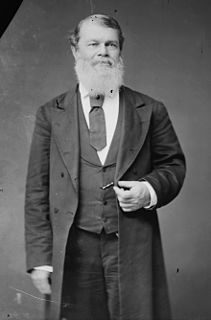It has been requested that the title of this article be changed to List of governors of Kentucky . Please see the relevant discussion on the discussion page. The page should not be moved unless the discussion is closed; summarizing the consensus achieved in support of the move. |
The Governor of Kentucky is the head of the executive branch of Kentucky's state government, [1] and serves as commander-in-chief of the state's military forces. [2] The governor has a duty to enforce state laws; [3] the power to either approve or veto bills passed by the Kentucky General Assembly; [4] the power to convene the legislature; [5] and the power to grant pardons, except in cases of treason and impeachment. [6] He or she is also empowered to reorganize the state government or reduce it in size. Historically, the office has been regarded as one of the most powerful executive positions in the United States. [7]

The Governor of the Commonwealth of Kentucky is the head of the executive branch of government in the Commonwealth of Kentucky. Fifty-seven men and one woman have served as Governor of Kentucky. The governor's term is four years in length; since 1992, incumbents have been able to seek re-election once before becoming ineligible for four years. Throughout the state's history, four men have served two non-consecutive terms as governor, and two others have served two consecutive terms. Kentucky is one of only five U.S. states that hold gubernatorial elections in odd-numbered years. The current governor is Matt Bevin, who was first elected in 2015.
The Kentucky National Guard comprises the:
A veto is the power to unilaterally stop an official action, especially the enactment of legislation. A veto can be absolute, as for instance in the United Nations Security Council, whose permanent members can block any resolution, or it can be limited, as in the legislative process of the United States, where a two-thirds vote in both the House and Senate will override a Presidential veto of legislation. A veto may give power only to stop changes, like the US legislative veto, or to also adopt them, like the legislative veto of the Indian President, which allows him to propose amendments to bills returned to the Parliament for reconsideration.
Contents
Fifty-eight individuals have held the office of Governor. Prior to a 1992 amendment to the state's constitution, the Governor was prohibited from succeeding himself in office, though four men (Isaac Shelby, John L. Helm, James B. McCreary and Happy Chandler) served multiple non-consecutive terms. Paul E. Patton, the first Kentucky Governor eligible for a second consecutive term under the amendment, won his reelection bid in 1999. James Garrard succeeded himself in 1800, before the constitutional provision existed.
The Constitution of the Commonwealth of Kentucky is the document that governs the Commonwealth of Kentucky. It was first adopted in 1792 and has since been rewritten three times and amended many more. The latter versions were adopted in 1799, 1850 and 1891.

Isaac Shelby was the first and fifth Governor of Kentucky and served in the state legislatures of Virginia and North Carolina. He was also a soldier in Lord Dunmore's War, the American Revolutionary War, and the War of 1812. While governor, he led the Kentucky militia in the Battle of the Thames, an action that was rewarded with a Congressional Gold Medal. Counties in nine states, and several cities and military bases, have been named in his honor. His fondness for John Dickinson's The Liberty Song is believed to be the reason Kentucky adopted the state motto "United we stand, divided we fall".

John LaRue Helm was the 18th and 24th governor of the U.S. Commonwealth of Kentucky, although his service in that office totaled less than fourteen months. He also represented Hardin County in both houses of the Kentucky General Assembly and was chosen to be the Speaker of the Kentucky House of Representatives four times. In 1838 his sole bid for federal office ended in defeat when his opponent, Willis Green, was elected to the U.S. House of Representatives.
William Goebel, who was elected to the office in the disputed election of 1899, remains the only Governor of any U.S. state to die from assassination while in office. [8] Martha Layne Collins, who held the office from 1983 to 1987, was the first woman to serve as governor and was only the third woman to serve as governor of any U.S. state who was not the wife or widow of a previous governor. [7] The 62nd and current Kentucky Governor is Republican Matt Bevin, who took office on December 8, 2015.

William Justus Goebel was an American politician who served as the 34th Governor of Kentucky for four days in 1900 after having been mortally wounded by an assassin the day before he was sworn in. Goebel remains the only state governor in the United States to be assassinated while in office.

Martha Layne Collins is an American former businesswoman and politician from the U.S. state of Kentucky; she was elected as the state's 56th governor from 1983 to 1987, the first woman to hold the office and the only one to date. Prior to that, she served as the 48th Lieutenant Governor of Kentucky, under John Y. Brown, Jr. Her election made her the highest-ranking Democratic woman in the U.S. She was considered as a possible running mate for Democratic presidential nominee Walter Mondale in the 1984 presidential election, but Mondale chose Congresswoman Geraldine Ferraro instead.

The Republican Party, also referred to as the GOP, is one of the two major political parties in the United States; the other is its historic rival, the Democratic Party.
































































